Assault on the Zaporozhye bridgehead
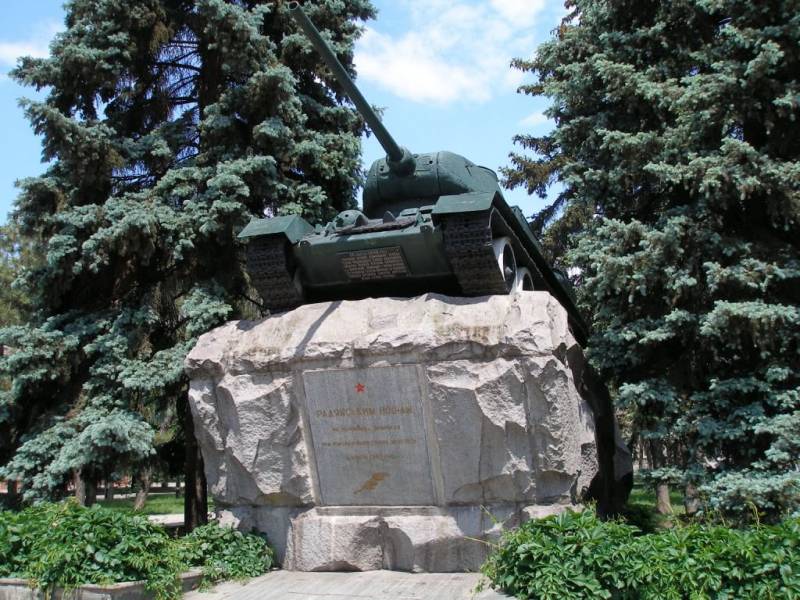 Monument to the Red Army soldiers who took part in the Zaporozhye operation. On this tank (T-34) the crew of Lieutenant N.L. Yatsenko was the first to break into the city captured by the Germans
Monument to the Red Army soldiers who took part in the Zaporozhye operation. On this tank (T-34) the crew of Lieutenant N.L. Yatsenko was the first to break into the city captured by the GermansGeneral situation
In September 1943, the Red Army achieved decisive success in the Battle of Donbass (Donbass is ours! 80 years ago the battle for the Dnieper began) and Dnieper. On September 2, the troops of the Voronezh Front liberated Poltava and advanced to Romny. Troops of the Southern Front (SF) liberated Stalino (Donetsk) and Mariupol. The Southwestern Front (SWF) liberated Proletarsk, Pervomaisk, Artyomovsk and Barvenkovo. Then Gulyai-Polye, Kuibyshevo, Pologi and Pavlograd were liberated.
The Soviet Headquarters attached great importance to the battle for the Dnieper, strengthening the fronts in the southern strategic direction with reserves, setting the task of quickly reaching the Dnieper, crossing it on the move and seizing bridgeheads on the Right Bank.
The German army in mid-September was forced to retreat from the Donbass and from the Left Bank to the Dnieper. At the same time, the Nazis used scorched earth tactics, destroyed and burned settlements, all industrial and transport infrastructure, communications facilities, burned crops, stole livestock (they took out what they could). Massive mining was used. The working population was forcibly driven west to slave labor in Western Europe, in Germany.
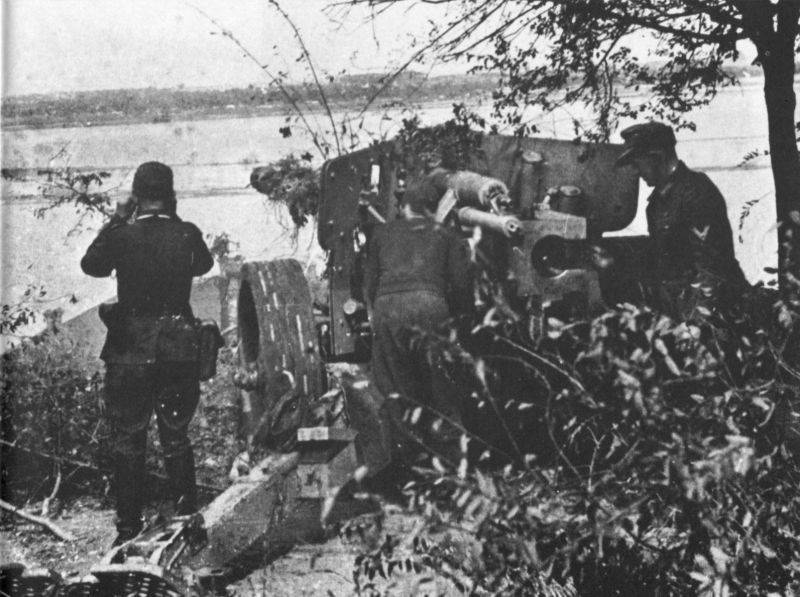
German 88-mm anti-tank gun PaK 43, installed in a position on the banks of the Dnieper. September 1943
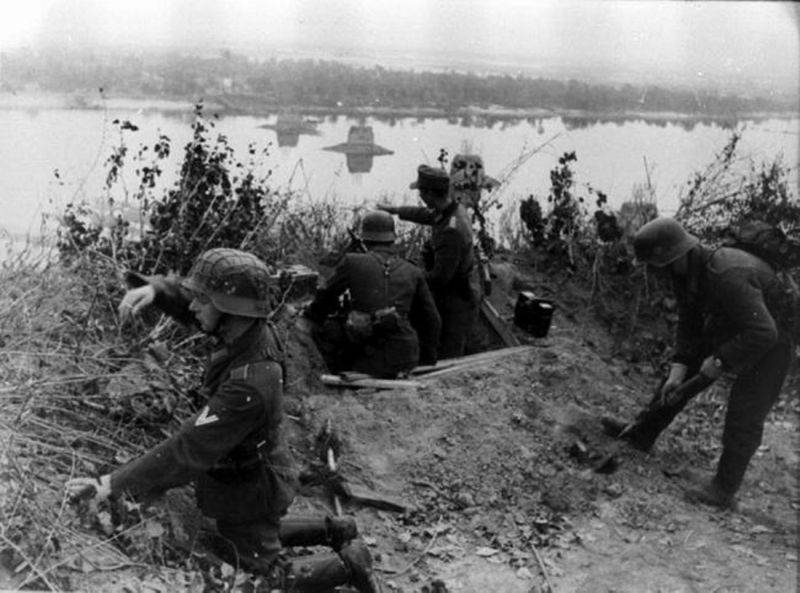
A German MG machine gun crew is preparing a firing position on the banks of the Dnieper
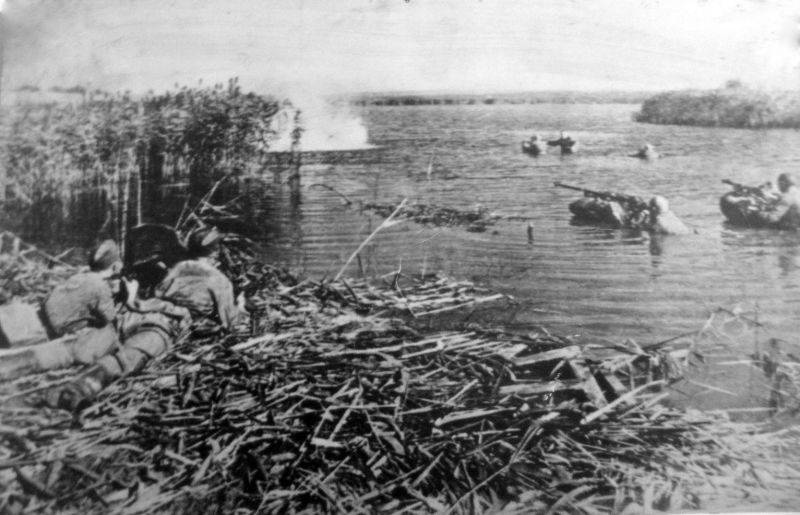
Crossing the Dnieper River by Soviet soldiers using improvised means
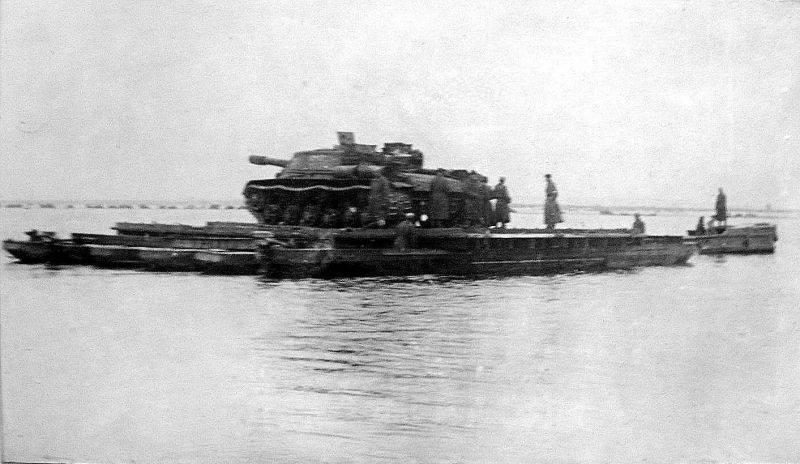
Crossing a self-propelled artillery unit on a ferry from the N2P park of the 103rd pontoon battalion across the Dnieper River in the Perevalochnaya area. October 1943
The German command planned to use the Dnieper line to stop Soviet troops. The Germans hoped that the Russians had exhausted their resources during the offensive and would not be able to immediately solve the difficult task of crossing such a large water barrier as the Dnieper. However, the Nazis miscalculated.
The offensive impulse of the Red Army was high, as was the motivation. Soviet soldiers rushed forward, liberating their native places! At first, the advanced units used improvised means to cross: boats, rafts, homemade ferries and even logs. Then they pulled up special crossing facilities and used them to create pontoon crossings. Great assistance was provided by local partisans and residents, who pointed out convenient areas, handed over boats, and helped restore crossings.
On September 21, the troops of the Central Front liberated Chernigov, the next day they reached the Dnieper and crossed it, occupying a bridgehead between the Dnieper and Pripyat rivers. In the Voronezh Front, Rybalko's 3rd Guards Tank Army captured a bridgehead in the Velikiy Bukrin area on the night of September 22. In the same area, troops of the 40th and 47th armies crossed the Dnieper. In fierce battles, the troops of the Voronezh Front expanded the Bukrinsky bridgehead. Units of the Steppe Front liberated Poltava on September 23 and reached the Dnieper from Cherkassy and Kremenchug.
As a result, the Red Army achieved a decisive turning point in the Battle of the Dnieper. The armies of the Central, Voronezh, Steppe and Southwestern fronts on a 700-kilometer front reached the Dnieper, knocking out the terrible enemy from the Left Bank. In the SWF, the crossing of the Dnieper began on September 25 south of Dnepropetrovsk. By the end of the month, Soviet troops captured 23 bridgeheads on the Right Bank. Only in Zaporozhye did the Wehrmacht maintain a bridgehead.
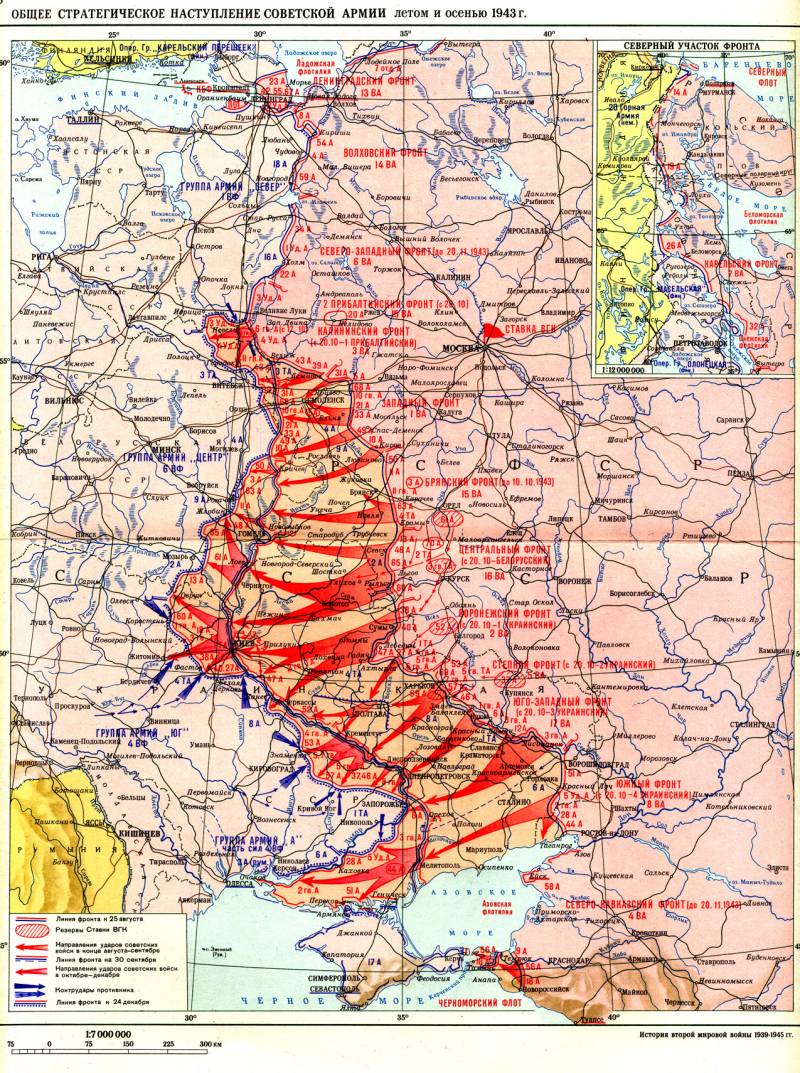
Nizhnedneprovsk strategic offensive operation
The battle for the Dnieper entered a new stage. Now the Red Army had to liberate one of the Russian capitals - Kyiv, expand the bridgeheads on the first bank of the Dnieper, preparing for the liberation of the Right Bank. It was also necessary to finish off the enemy on the Left Bank - to liquidate German bridgeheads.
Therefore, without a pause, a powerful operation of the Red Army was launched in the lower reaches of the Dnieper to eliminate enemy bridgeheads. The Lower Dnieper strategic operation was carried out by troops of the Steppe (then 2nd Ukrainian), Southwestern (3rd Ukrainian) and Southern (4th Ukrainian) fronts. As part of this operation, the following front-line offensive operations were carried out: Melitopol, Zaporozhye, Pyatikhatsk, Znamensk and Dnepropetrovsk.
By the beginning of the operation, the number of Soviet troops amounted to 1,5 million people (112 divisions, 8 tank and mechanized corps, 17 brigades and 3 fortified areas), over 24 thousand guns and mortars, over 1,1 thousand tanks and self-propelled guns, 2 thousand. combat aircraft. It is worth noting that the troops were exhausted and bleeding from previous battles; the divisions had no more than 5 thousand fighters. The troops were cut off from supply bases, experienced an acute shortage of fuel and ammunition, transportation means, heavy weapons were lagging behind, and did not have time to relocate Aviation, prepare the bases for it.
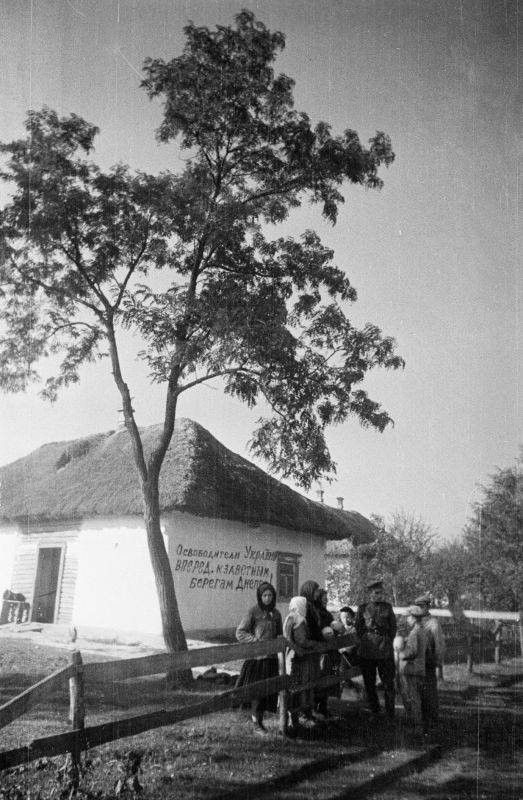
The inscription on a hut in the Kyiv region: “Liberators of Ukraine, forward to the treasured banks of the Dnieper!”
Meanwhile, the German command feverishly tried to hold the Eastern (Dnieper) Wall, eliminate enemy bridgeheads on the Right Bank and hold its own on the Left Bank. The divisions, thinned out in fierce battles, were hastily put in order as best they could, replenished, and reinforcements were transferred from Western Europe, from calmer areas in the central and northern directions of the Russian Front. A relatively developed network of communications on the Right Bank made it possible to maneuver forces, transfer reserves, and transport fuel and ammunition.
On the lower reaches of the Dnieper, the defense was held by the troops of the 1st Panzer and 8th Field Army from Army Group South under the command of Manstein and the 6th Field Army of Army Group A of Kleist. In total, up to 770 thousand people, 8 thousand guns and mortars, 800 tanks and self-propelled guns, 1 thousand aircraft of the 4th Air Force fleet.
On September 26, 1943, in the lower reaches of the Dnieper and on the Molochnaya River, the troops of the Southern Fleet of General Tolbukhin went on the offensive (Melitopol operation), and in the Kremenchug region - the troops of the Steppe Front of General Konev. Tolbukhin's troops were unable to break through the enemy's defenses; our troops stopped the offensive in order to better prepare. By September 30, Konev’s armies had liquidated the enemy’s Kremenchug bridgehead, crossed the Dnieper on the move and captured bridgeheads on the right bank. At the beginning of October, the Steppe Front and the Southwestern Front expanded their bridgeheads and united them.
On October 9, the SF resumed the offensive, breaking through the strong enemy defenses on the river. Molochnaya, made his way to Melitopol, which covered the approaches to the Crimea and the lower reaches of the Dnieper. On October 13, units of the 51st Army broke into the city and liberated Melitopol by October 23. The German command urgently strengthens the grouping in the Melitopol direction to 16 divisions, of which 8 were transferred from Crimea.
The Germans were unable to stop the Soviet troops immediately. On October 30, our troops entered Genichesk and occupied the coast of Sivash. On November 1, the Turkish Wall and the Perekop Isthmus were broken through, and on November 5, Sivash was crossed. At the same time, the troops of the 4th Ukrainian Front reached the lower reaches of the Dnieper and completely cleared its eastern bank in their zone, all of Northern Tavria was liberated. However, it was not possible to immediately break into Crimea and liberate it.
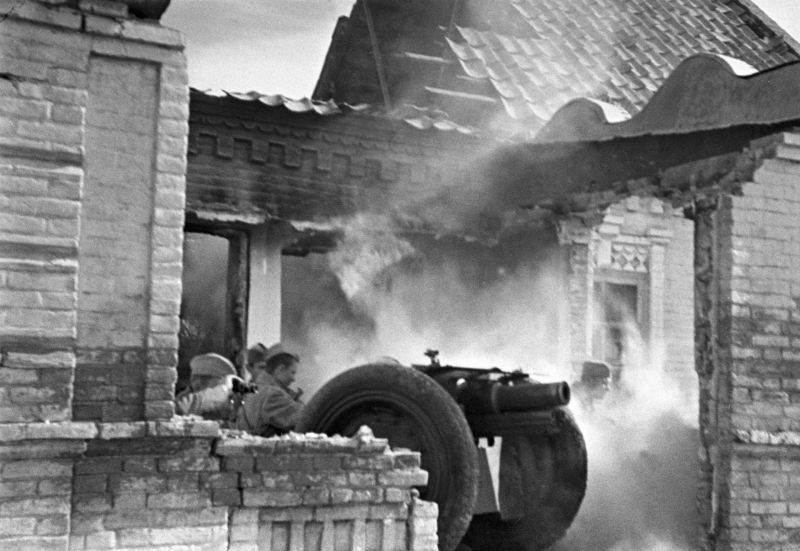
The crew of a Soviet 76-mm regimental gun in a street battle for the liberation of Melitopol
Zaporozhye bridgehead
The Zaporozhye bridgehead was given great importance, both at Soviet Headquarters and at German Headquarters. From the bridgehead it was possible to strike at the flanks and rear of our troops, both on the Left Bank and those that were already on the Right Bank. The Wehrmacht could try to restore part of the position on the Left Bank of the Dnieper. Zaporozhye covered such important economic areas as Krivoy Rog and Nikopol (iron and manganese mines).
It was an important railway junction through which the Wehrmacht group was supplied in the Melitopol direction. Militarily, the Zaporozhye bridgehead, which reached 40 km along the front and 20 km in depth, covered the defensive line on the river from the north. Molochnaya, and threatened our armies from the south, which were advancing in the Dnepropetrovsk direction. Therefore, the German Headquarters demanded to hold Zaporozhye at any cost.
The bridgehead was well fortified, there were external and internal defensive contours, an intermediate line and the city of Zaporozhye itself. The defensive lines had numerous pillboxes and bunkers, underground shelters, dugouts, anti-tank and anti-personnel barriers.
The Zaporozhye Wehrmacht group included 5 infantry and one motorized divisions, a separate tank battalion, two divisions of assault guns and other units from Mackensen's 1st Panzer Army. A total of 35 thousand people, almost 600 guns and mortars, about 200 tanks and assault guns.
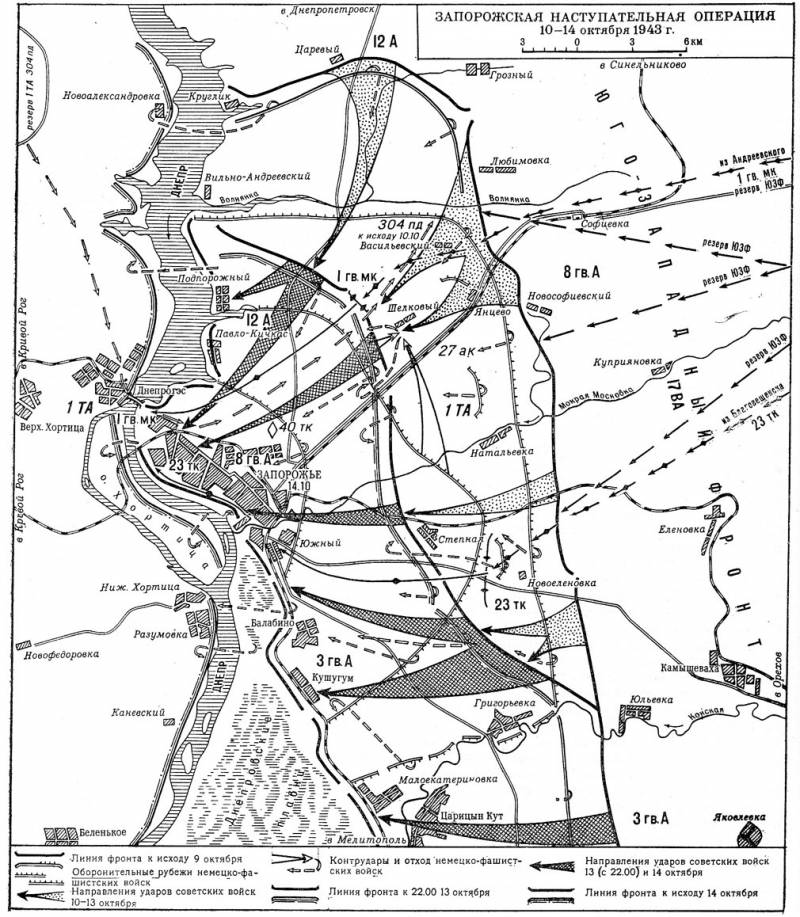
The 3rd and 8th Guards and 12th armies of Lelyushenko, Chuikov and Danilov, as well as the 17th Air Army, were involved in the operation from the Southwestern Front under the command of Malinovsky. The main tasks were assigned to the 8th Guards Army. The armored group included the 1st Guards Mechanized and 23rd Tank Corps, a separate tank brigade and 4 tank regiments.
The plan of the Soviet command provided for simultaneous attacks from the northeast, east and southeast in converging directions towards Zaporozhye. The advantage at the beginning of the operation was with the Southwestern Front: infantry - 2,2:1; artillery – 2,1:1; tanks - 1,6:1.
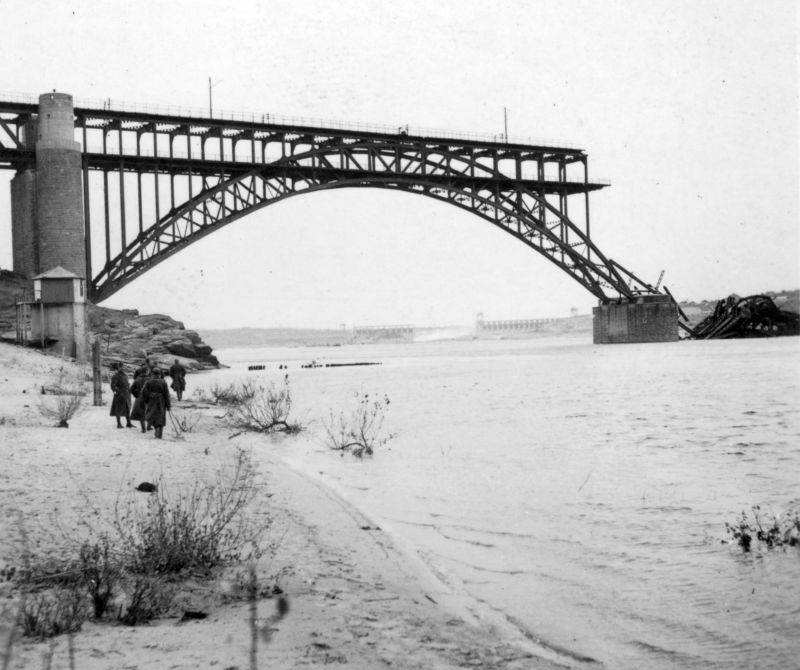
The destroyed railway bridge across the Dnieper River in Zaporozhye and the Dneproges hydroelectric power station blown up in August 1941 (in the distance). Hungarian soldiers are walking towards the bridge. 1943
Assault
The assault on the bridgehead began on the morning of October 10, 1943. At 7:50 a.m., after a 40-minute artillery barrage, the troops launched an attack. Even during the artillery preparation, sappers threw bridges and ladders over the ditches and made passages for artillery. When the infantry crossed the ditch, the sappers blew up the walls in a number of places to create passages for the tanks.
The Germans fought fiercely, especially in the offensive zone of the 8th Guards Army. During the day, they counterattacked 11 times with the support of tanks and self-propelled guns. Both sides suffered heavy losses. Chuikov's army penetrated the enemy's defenses by only 1–2 km. The troops of the 12th Army operated more successfully on the northern flank. On the night of October 12, its units occupied a number of important heights north of Zaporozhye. During two days of stubborn fighting, our troops broke through the outer defensive line. The Germans withdrew units to the internal circuit, which was more powerful.
On the night of October 13-14, our troops launched an assault on the city. The Nazis were unable to stop the fierce and powerful attack. The defense was broken in several areas. Advancing in the southeast, units of the 23rd Tank Corps broke into the southern outskirts of Zaporozhye at 2 a.m. Having defeated the enemy in the southern part of the city, tanks with troops from the 59th Guards Division made their way to the center. The defeated German troops rolled back to the right bank of the Dnieper.
By the end of October 14, Soviet soldiers liberated Zaporozhye. During the fierce 5-day battle, the Germans lost about 23 thousand soldiers.
On October 14 at 23:30 in Moscow they saluted the troops that liberated Zaporozhye with twenty artillery salvoes from two hundred and twenty-four guns.
The Red Army eliminated an important enemy bridgehead. Thus, the position of our army on the southern sector of the front significantly improved. The German 6th Army, which defended the approaches to the Crimea and the lower reaches of the Dnieper, was put in a difficult situation. The position of the Wehrmacht in the Dnepropetrovsk and Krivoy Rog directions worsened.
The quick assault saved the country's most important industrial facility, the Dnieper Hydroelectric Power Station. The Nazis did not have time to completely destroy it: they blew up the station building, destroyed all the equipment, and part of the dam.
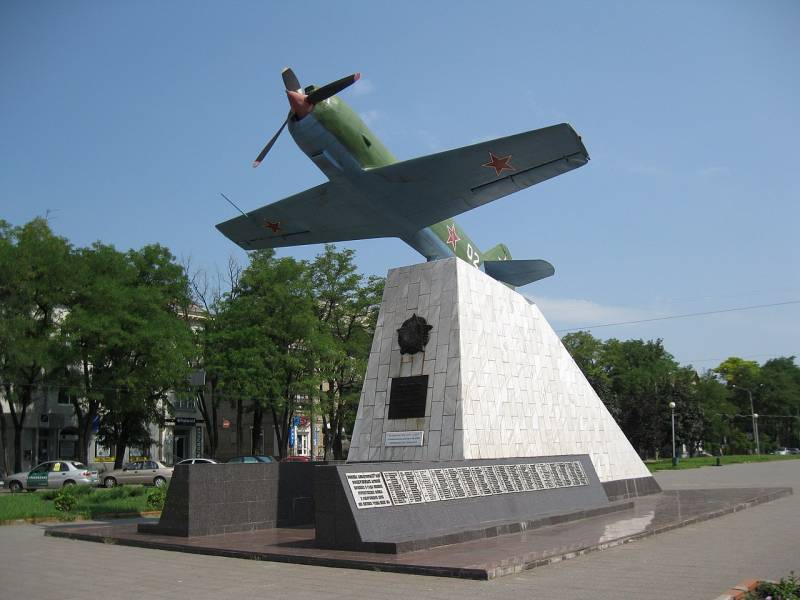
Monument to Soviet pilots - liberators of Zaporozhye
Information